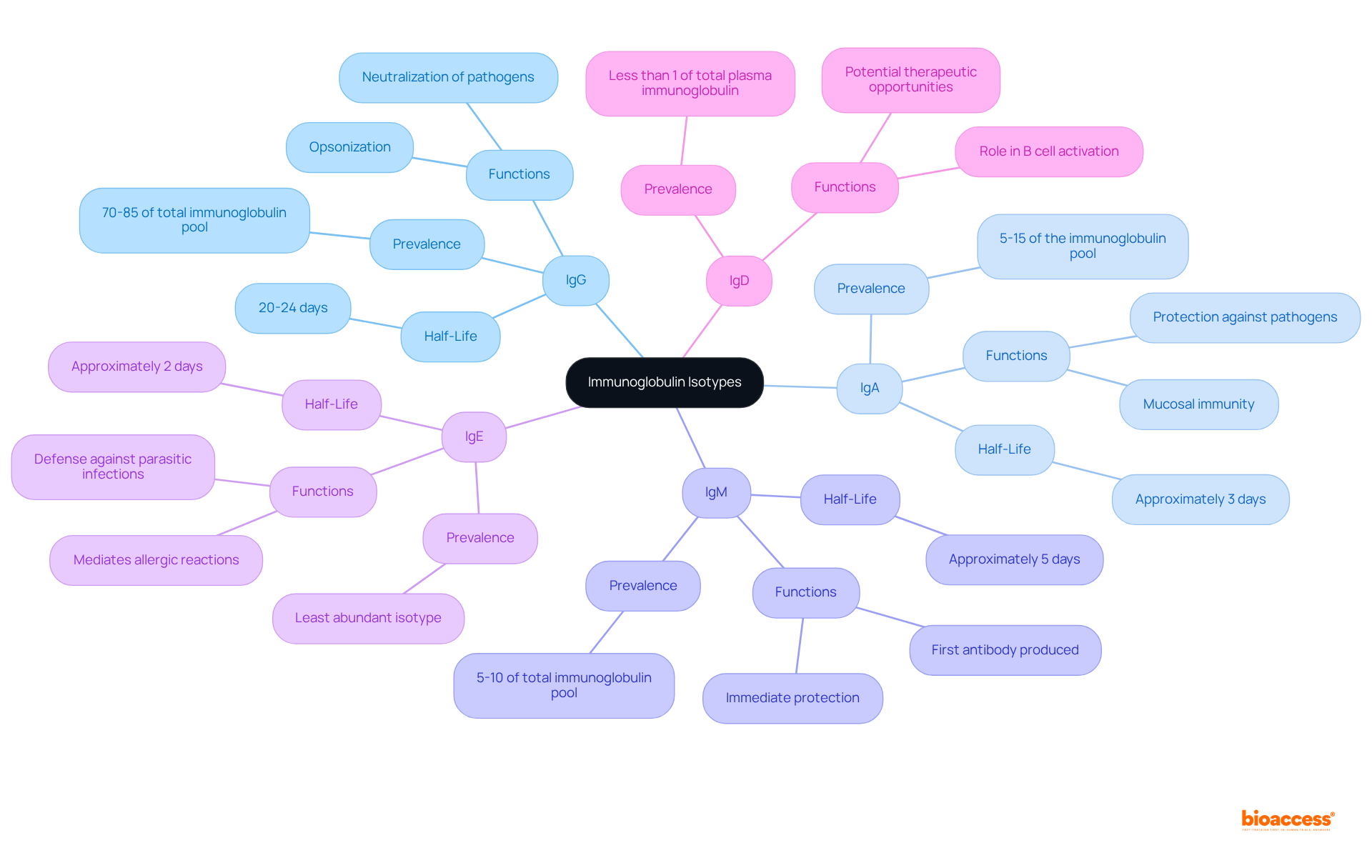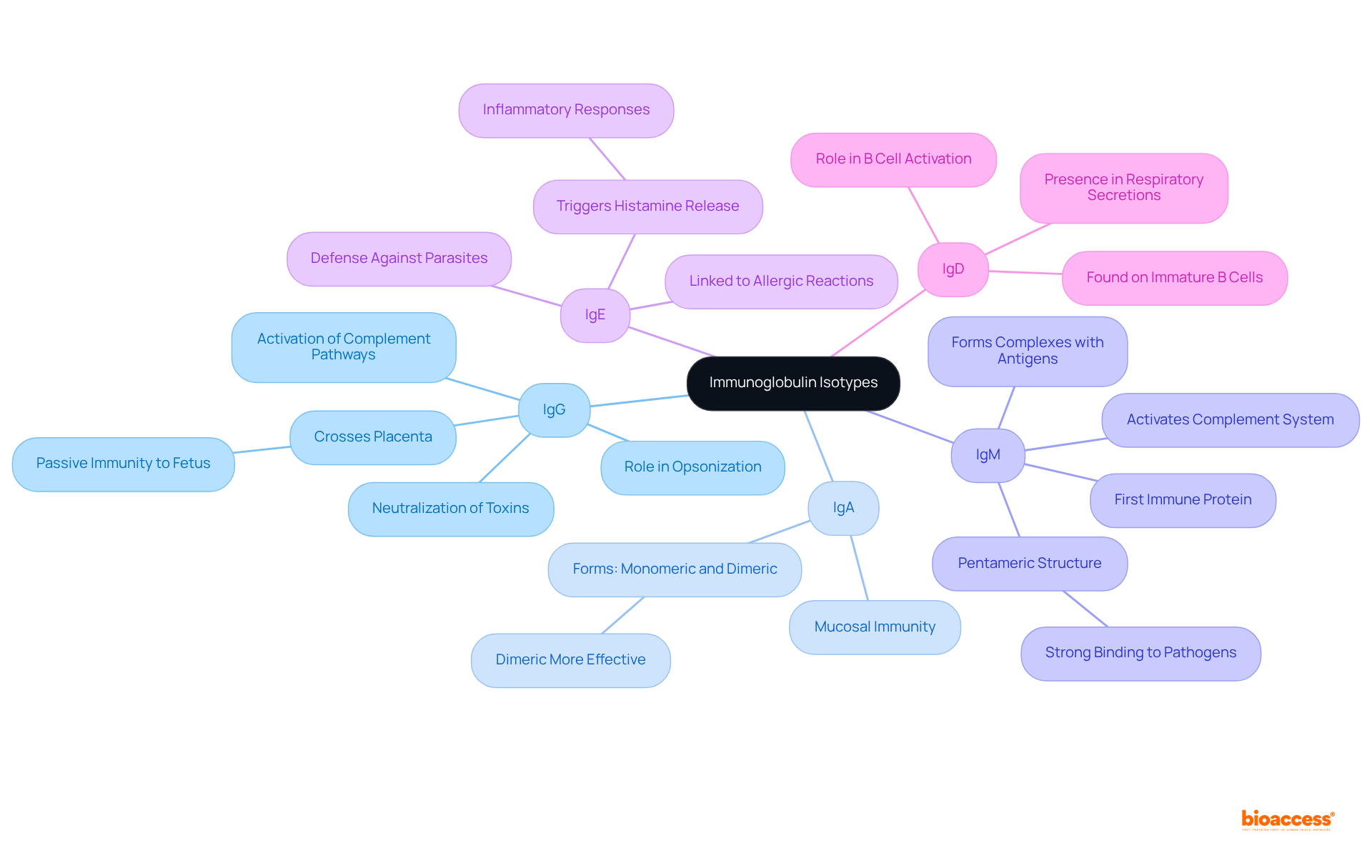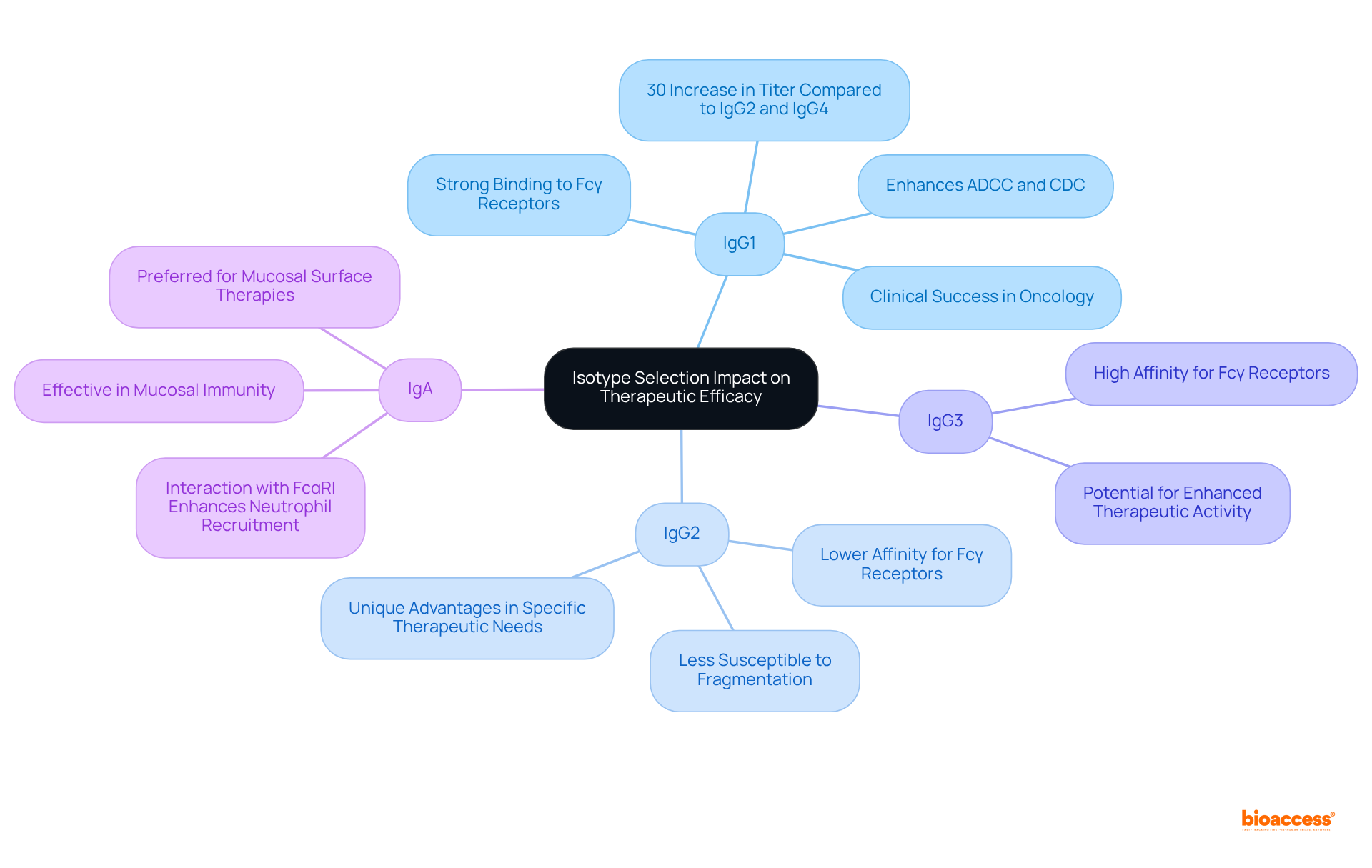


The article underscores the critical significance of immunoglobulin isotypes in clinical research, asserting their distinct roles in immune responses and therapeutic applications. It is essential to grasp the nuances of these isotypes; for instance, IgG's predominance in opsonization and IgE's involvement in allergic reactions are pivotal for devising effective diagnostic and treatment strategies tailored to individual patient profiles. This understanding not only enhances clinical outcomes but also drives innovation in therapeutic approaches, reinforcing the need for a comprehensive grasp of immunoglobulin functions in the evolving Medtech landscape.
Understanding the intricate world of immunoglobulin isotypes is essential for advancing clinical research and improving patient care. These distinct antibody forms—IgG, IgA, IgM, IgE, and IgD—each play unique roles in the immune system, influencing everything from pathogen defense to therapeutic efficacy. The challenge lies in deciphering how these isotypes can be strategically utilized to enhance treatment outcomes and tailor personalized medicine approaches.
What insights can be gleaned from the latest research on immunoglobulin isotypes that could revolutionize clinical practices and patient management?
Distinct forms of immunoglobulin isotypes, characterized by variations in their heavy chain structure and biological functions, are pivotal in both the immune system and clinical research. The five main isotypes—IgG, IgA, IgM, IgE, and IgD—each play crucial roles in shaping the body's response to pathogens and influencing treatment approaches. For instance, IgG accounts for 70-85% of the total immunoglobulin pool and has a half-life of 20-24 days, making it essential for opsonization and neutralization of pathogens. This establishes IgG as a fundamental element in antibody development. In contrast, although IgE is the least abundant isotype, it plays a critical role in mediating allergic reactions and defending against parasitic infections. Understanding immunoglobulin isotypes is vital for developing effective diagnostic and treatment strategies, as these isotypes determine the specificity and efficacy of immune responses in various clinical contexts.
Food allergies affect over 220 million people worldwide, underscoring the importance of this subject and the need for effective treatment approaches. Recent advancements in isotype-specific diagnostics and treatments highlight the significance of tailoring therapies according to antibody profiles. Emerging trends suggest that personalized medicine could significantly enhance patient outcomes. For example, research indicates that elevated peanut-specific IgG4 levels correlate with reduced chances of severe allergic reactions, illustrating how immunoglobulin isotypes can directly influence treatment strategies. This foundational knowledge is indispensable for researchers and clinicians engaged in immunology and therapeutic development.

IgG: As the most prevalent immunoglobulin in serum, IgG plays a crucial role in opsonization, neutralization of toxins, and the activation of complement pathways. Notably, it is the only isotype capable of crossing the placenta, thereby providing passive immunity to the fetus.
IgA: Predominantly located in mucosal areas such as the gut and respiratory tract, IgA is essential for mucosal immunity. It exists in two forms: monomeric and dimeric, with the latter being more effective in preventing pathogen adherence to mucosal surfaces.
IgM: As the first immune protein generated in response to an infection, IgM is highly effective in forming complexes with antigens and activating the complement system. Its pentameric structure facilitates strong binding to pathogens.
IgE: Primarily linked to allergic reactions and defense against parasitic infections, IgE binds to allergens and triggers histamine release from mast cells and basophils, leading to inflammatory responses.
IgD: While its exact function remains less understood, IgD is believed to play a role in the activation and regulation of B cells. It is primarily found on the surface of immature B cells and in respiratory tract secretions.
Understanding immunoglobulin isotypes is vital for researchers and clinicians, as these isotypes significantly influence the formulation and application of treatment proteins in clinical environments.

The selection of immunoglobulin isotypes is pivotal in the development of therapeutic antibodies, as different isotypes exhibit distinct affinities for Fc receptors on immune cells, significantly influencing their capacity to facilitate immune responses. Notably, IgG1 and IgG3 are acknowledged for their strong binding to Fcγ receptors, which amplifies antibody-dependent cellular cytotoxicity (ADCC) and complement-dependent cytotoxicity (CDC). Indeed, studies reveal that IgG1 monoclonal antibodies (mAbs) show a remarkable enhancement in effector function, with a reported 30% increase in titer compared to IgG2 and IgG4PAA mAbs. Conversely, IgA is particularly effective in mucosal immunity, rendering it a preferred option for therapies aimed at mucosal surfaces.
The pharmacokinetics and half-life of medical antibodies are also shaped by class selection. For instance, IgG immunoglobulins typically possess a longer half-life due to their ability to recycle via the neonatal Fc receptor (FcRn), which is advantageous for maintaining effective levels in patients. Recent innovations, such as the glycoengineered anti-CD20 obinutuzumab (GA101), have showcased clinical success, nearly doubling progression-free survival in chronic lymphocytic leukemia patients compared to rituximab, highlighting the practical implications of antibody selection.
Recent research underscores that the choice of antibody type can influence the formation of anti-drug antibodies (ADAs), which may undermine treatment efficacy. Grasping these dynamics is essential for optimizing therapeutic strategies and improving patient outcomes. Therefore, meticulous consideration of isotype selection is crucial when developing antibody-based therapies to ensure maximum efficacy and safety.

Understanding the various immunoglobulin isotypes is essential for advancing clinical research and improving therapeutic outcomes. Each isotype—IgG, IgA, IgM, IgE, and IgD—plays a distinct role in the immune response, influencing both the body's defense mechanisms and the effectiveness of treatment strategies. Grasping the nuances of these isotypes allows researchers and clinicians to tailor their approaches, ultimately enhancing patient care and treatment efficacy.
The article highlights the critical functions of each immunoglobulin isotype, such as:
Furthermore, it underscores the importance of isotype selection in therapeutic development, where the choice of antibody can significantly affect pharmacokinetics, efficacy, and patient outcomes. Recent advancements in personalized medicine and isotype-specific diagnostics further illustrate the potential for improved treatment strategies based on a deeper understanding of immunoglobulin isotypes.
In light of this information, it is clear that ongoing research into immunoglobulin isotypes is vital for the future of clinical immunology. As personalized medicine continues to evolve, the insights gained from studying these isotypes will be crucial in shaping innovative therapies and improving health outcomes. Engaging with the latest trends in immunoglobulin isotype research will not only enhance clinical practices but also pave the way for breakthroughs in understanding health and disease.
What are immunoglobulin isotypes?
Immunoglobulin isotypes are distinct forms of antibodies characterized by variations in their heavy chain structure and biological functions, playing crucial roles in the immune system and clinical research.
How many main immunoglobulin isotypes are there, and what are they?
There are five main immunoglobulin isotypes: IgG, IgA, IgM, IgE, and IgD.
What is the significance of IgG in the immune response?
IgG accounts for 70-85% of the total immunoglobulin pool and has a half-life of 20-24 days, making it essential for opsonization and neutralization of pathogens, thus being a fundamental element in antibody development.
What role does IgE play in the immune system?
IgE is the least abundant isotype but is critical in mediating allergic reactions and defending against parasitic infections.
Why is understanding immunoglobulin isotypes important for clinical research?
Understanding immunoglobulin isotypes is vital for developing effective diagnostic and treatment strategies, as they determine the specificity and efficacy of immune responses in various clinical contexts.
How prevalent are food allergies globally, and why is this relevant to immunoglobulin isotypes?
Food allergies affect over 220 million people worldwide, highlighting the importance of immunoglobulin isotypes in developing effective treatment approaches for allergic reactions.
What advancements have been made in isotype-specific diagnostics and treatments?
Recent advancements suggest that personalized medicine, which tailors therapies according to antibody profiles, could significantly enhance patient outcomes.
Can immunoglobulin isotypes influence treatment strategies?
Yes, research indicates that elevated levels of specific immunoglobulin isotypes, such as peanut-specific IgG4, correlate with reduced chances of severe allergic reactions, illustrating their direct influence on treatment strategies.